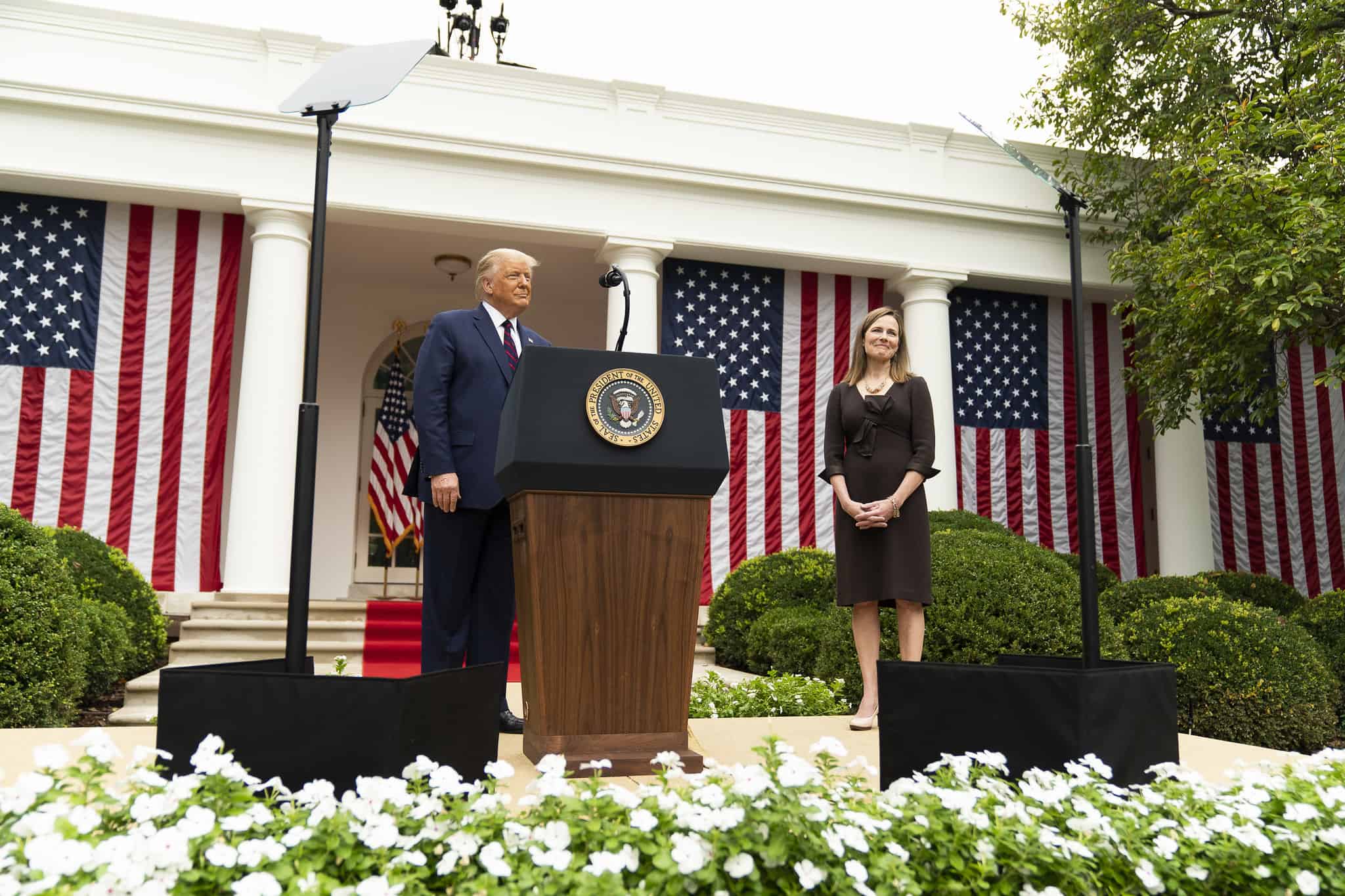
Jenny Hunter is an Associate General Counsel at the Service Employees International Union.
Last week’s confirmation hearings for Judge Amy Coney Barrett contained all the elements you probably put on your 2020 SCOTUS hearing bingo card, if you were in to that sort of thing. The Republican senators talked a lot about Judge Barrett’s seven children. The Democratic Senators talked about the life and death consequences if the Supreme Court strikes down the Affordable Care Act in the challenge it will hear on November 10. Judge Barrett, for her part, maintained a neutral facial expression for days, and refused to comment on such “controversial” matters as whether climate change exists, whether poll taxes are Constitutional, and whether presidents should commit to peaceful transfers of power.
The hearing also included plenty of uncritical references to Judge Barrett’s judicial philosophies of “originalism” and “textualism.” But a brief exchange between Judge Barrett and Senator Diane Feinstein (D-CA) about an age discrimination case, Kleber v. CareFusion, unintentionally illuminated how textualism allows judges to be both overconfident in their decisions and falsely modest about the policy implications of those decisions.
As Andy Strom and Samuel Estreicher explained previously, the 7th Circuit in Kleber significantly narrowed protections for older job applicants. It did so by ruling that the Age Discrimination in Employment Act (ADEA) allows only current employees, not outside job applicants, to challenge employment practices that have a disparate impact based on age. That meant that Mr. Kleber, the 57-year-old job applicant plaintiff in the case, could not challenge a job requirement that applicants must have “no more than 7 years” of relevant experience.
Senator Feinstein prefaced her questioning on Kleber by discussing the discrimination that older workers face. She then asked Judge Barrett about the purpose of the ADEA. Barrett did not answer, but instead described the case as involving a straightforward reading of the text:
BARRETT: Well, in Kleber v. CareFusion, I joined a majority of the en banc court. So that was a case that we heard as a full court. And the question is whether the prohibition on age discrimination covered applicants or only employees. And the statute said employees. And so, an applicant isn’t an employee so the majority said that the statute by its terms didn’t cover the conduct. (Emphasis added)
But I think that’s an instance, you know, we — I talked yesterday quite a bit about whose role it is to update statutes or extend them. And I think that’s an instance in which Congress could well address this problem by amending the statute to include applicants in it.
The problem with Judge Barrett’s answer is that, contrary to her claim, the ADEA does not just “say employees.” The relevant provision makes it illegal for an employer:
to limit, segregate, or classify his employees in any way which would deprive or tend to deprive any individual of employment opportunities or otherwise adversely affect his status as an employee, because of such individual’s age.
29 U.S.C. § 623(a)(2). The majority opinion concluded that “any individual” did not include outside job applicants, which is a fairly mean feat for a judicial philosophy that purports to be faithful to the plain meaning of texts. The majority reached its conclusion primarily through a grammatical analysis that concluded that the phrase “status as an employee” must be read to limit the scope of “any individual.”
This reading was by no means the only way to interpret the anything-but-clear statute, as the two dissents pointed out. Among other things, the majority did not explain why, if Congress only wanted to cover employees, it didn’t just say “employees” “rather than “any individual.” It didn’t explain how a law making it illegal to deprive “any individual” of “employment opportunities” could be read so as not to cover job applicants. And, of course, it did not grapple with Congress’ purposes in passing the ADEA, which included reducing high rates of unemployment among older job-seekers. As Sam Estreicher said in his earlier post about the case, the majority decision is a prime example of “untethered textualism”: a close reading divorced from any constraining consideration of the purpose of the law.
The fact that Barrett misremembered—or misrepresented—the case as being a straightforward one in which “the statute said employees” is revealing. Textualism only really works when a judge can claim that statutory language is clear. Once a textualist acknowledges that the meaning of a law is ambiguous – say, because human language is ambiguous – she has opened the door to considering other evidence about what the law means, something she is ideologically disinclined to do.
So, despite having grappled less than two years ago with strenuous disagreement among her colleagues about the meaning of the ADEA, Judge Barrett now overconfidently and incorrectly remembers her conclusion – that the section only applied to employees – as though that was what the statute literally said.
Barrett’s answer also points to a related problem with textualism: it allows judges to cloak themselves in false modesty about the policy results of their decisions. Textualist judges are happy to discuss grammar and dictionary definitions, but they reject questions about whether their conclusions are consistent with the purpose of the law, or whether the outcome makes sense or is just. As Barrett told Feinstein, those matters are up to Congress. But applying malleable rules of textual analysis to ambiguous texts allows judges to make decisions with important policy implications without acknowledging that they are doing so. In this case, it allowed Judge Barrett to subvert Congress’ goal of promoting employment among older people by prohibiting age discrimination against job applicants, and to claim she was doing so out of deference to Congress.
The sales pitch for textualism, that it keeps the judiciary in its lane of applying the law while allowing the elected branches to make policy decisions, has some intuitive appeal. But Judge Barrett’s answers about Kleber demonstrate that far from confining the courts to the limited role of applying the law to a set of facts, textualism allows judges to overconfidently declare what the law is, while providing a cover of false modesty about what they are doing. The assurance that a Justice Barrett will confidently scrutinize the words of statutes while ignoring their purposes and the impact of her rulings on real people should be cold comfort to workers.










Daily News & Commentary
Start your day with our roundup of the latest labor developments. See all
April 24
Workers in Montreal organize the first Amazon warehouse union in Canada and Fordham Graduate Student Workers reach a tentative agreement with the university.
April 23
Supreme Court hears cases about 10(j) injunctions and forced arbitration; workers increasingly strike before earning first union contract
April 22
DOL and EEOC beat the buzzer; Striking journalists get big NLRB news
April 21
Historic unionization at Volkswagen's Chattanooga plant; DOL cracks down on child labor; NY passes tax credit for journalists' salaries.
April 19
Alabama and Louisiana advance anti-worker legislation; Mercedes workers in Alabama set election date; VW Chattanooga election concludes today.
April 18
Disneyland performers file petition for unionization and union elections begin at Volkswagen plant in Tennessee.